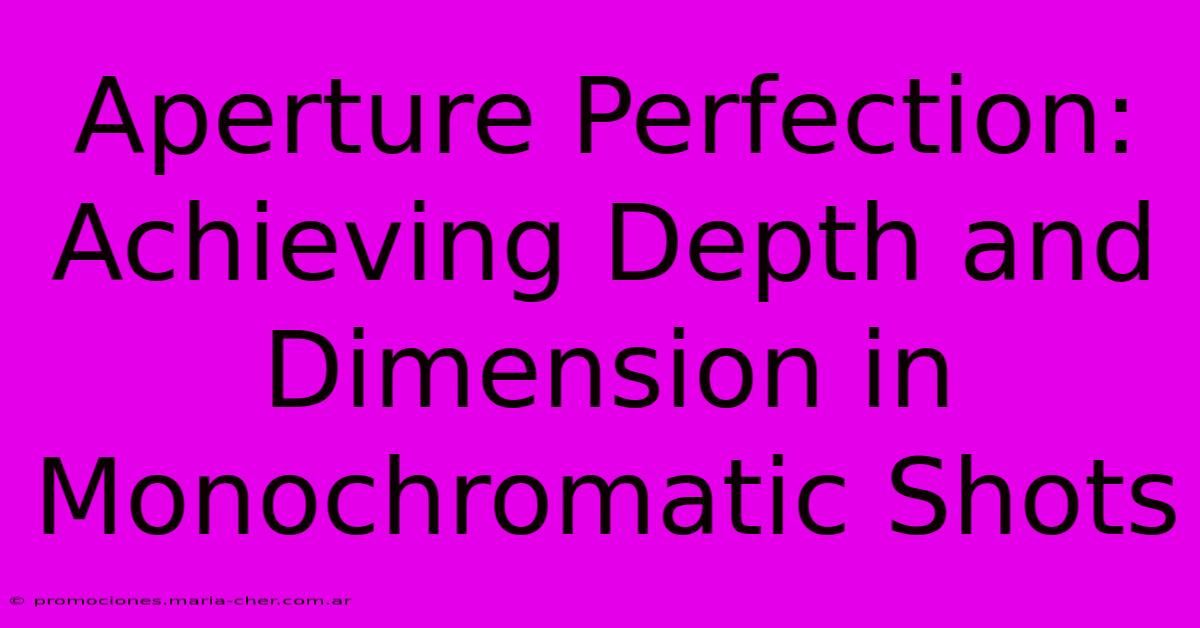Aperture Perfection: Achieving Depth And Dimension In Monochromatic Shots

Table of Contents
Aperture Perfection: Achieving Depth and Dimension in Monochromatic Shots
Monochromatic photography, with its stark beauty and emotional resonance, offers a unique challenge and reward. Stripping away color allows the photographer to focus intensely on texture, form, and light – elements amplified by skillful aperture control. This article explores how mastering aperture settings can unlock breathtaking depth and dimension in your black and white images.
Understanding Aperture's Role in Monochrome
Aperture, controlled by your lens' diaphragm, dictates the amount of light reaching your sensor. Expressed as an f-stop (e.g., f/2.8, f/8, f/22), it directly impacts depth of field – the area of your image that appears in sharp focus. In monochrome photography, this control is even more critical because the absence of color necessitates a stronger reliance on other visual cues to create impact.
Wide Apertures (f/2.8, f/4): Emphasizing Shallow Depth of Field
Using a wide aperture creates a shallow depth of field, blurring the background and isolating your subject. This technique is ideal for:
- Portraiture: Drawing attention to the subject's features while softening the background, creating a dreamy, artistic effect.
- Abstract Photography: Focusing on specific textures or details, making them pop against a blurred, almost painterly backdrop.
- Low-Light Conditions: Letting in more light, enabling you to shoot with faster shutter speeds and avoid motion blur.
Narrow Apertures (f/8, f/11, f/16): Maximizing Depth of Field
Narrow apertures produce a large depth of field, keeping both foreground and background elements sharp. This is perfect for:
- Landscape Photography: Ensuring everything from the intricate details of the foreground to the distant mountains is in focus, creating a sense of scale and grandeur.
- Architectural Photography: Maintaining sharpness across the entire structure, highlighting architectural details and textures.
- Street Photography: Capturing sharp details throughout the scene, conveying the context and atmosphere of the environment.
Beyond f-stops: Mastering other Techniques for Depth and Dimension
While aperture is crucial, other photographic elements contribute significantly to creating depth and dimension in monochrome:
Light and Shadow: Strong contrasts between light and shadow are amplified in monochrome, adding drama and three-dimensionality. Experiment with backlighting, side lighting, and Rembrandt lighting to sculpt your subject and create striking visual interest.
Leading Lines: Utilize natural or man-made lines (roads, fences, rivers) to guide the viewer's eye through the image, creating a sense of depth and perspective.
Texture: Monochrome photography excels at highlighting texture. Focus on photographing surfaces with strong textural qualities – rough bark, weathered wood, or intricately woven fabrics – to add visual richness.
Post-Processing for Enhancing Depth and Dimension
Even with perfect in-camera technique, post-processing can refine your monochrome images. Tools like:
- Contrast Adjustments: Boosting contrast enhances the separation between light and shadow, further emphasizing depth.
- Dodging and Burning: Subtly lightening (dodging) or darkening (burning) specific areas adds dimension and shapes your subject.
- Local Adjustments: Using brushes or gradients to target specific areas allows for precise control over contrast, brightness, and clarity.
Conclusion: Embrace the Monochrome Challenge
Mastering aperture in monochrome photography is a journey of exploration and refinement. By understanding the interplay between aperture, lighting, and post-processing, you can unlock the full potential of black and white photography and create images that are deeply expressive, technically brilliant, and visually stunning. Remember to experiment, learn from your mistakes, and enjoy the creative process! Your unique vision will shine through.

Thank you for visiting our website wich cover about Aperture Perfection: Achieving Depth And Dimension In Monochromatic Shots. We hope the information provided has been useful to you. Feel free to contact us if you have any questions or need further assistance. See you next time and dont miss to bookmark.
Featured Posts
-
The X Commandments Of Creating Magnetic Transition Images For Email Signatures
Feb 07, 2025
-
Light Up Your Photos Discover The Allure Of Black And White Photo Spot Lighting
Feb 07, 2025
-
Virginia Heart Attack Hospital Costs Demystified How To Save Your Wallet And Your Health
Feb 07, 2025
-
Breathe New Life Into Your Decor The Enchanting Appeal Of Bulk Babys Breath
Feb 07, 2025
-
Elevate Your Construction Business The Power Of Professionally Designed Business Cards
Feb 07, 2025
